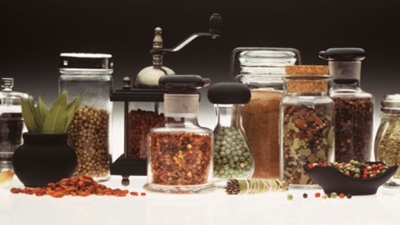
Last night, I was sautéing some vegetables to add to my homemade pasta sauce. I added in my usual mix of healthy spices—garlic powder, black pepper, oregano, and salt—when I stopped and wondered: are these spices actually healthy? Or should I be using the real thing?
It’s rare to find a home that doesn’t have a basic spice rack, even if it’s just filled with two or three spices. But since I come from a Middle Eastern background, our spice rack is filled with tons of healthy spices—or so I thought. We don’t hesitate before pouring black pepper or paprika over our food, and I’ve never stopped to wonder if what I was adding harmed or benefited my food. Just what’s really in my healthy spices?
4 Healthy Spices To Use When Cooking
1. Salt:
Table salt is made from underground salt deposits. Food manufacturers also add both an anti-caking agent to prevent the salt from lumping together and iodine, which is an essential nutrient for our health. The downside? Table salt loses many natural minerals when it’s processed.
While adding a little bit of salt to your food is not necessarily unhealthy, the problem is that salt contains sodium chloride, and consuming too much sodium is linked to high blood pressure.
Many Americans consume double or triple their daily recommended intake of sodium (2,300 mg), because fast food, frozen food, and processed food all use sodium as a preservative. If you rely on sea salt as one of your healthy spices, then know it contains just as much sodium as table salt.
The bottom line: if you eat a lot of sodium-filled food, then keep this off your list of healthy spices. However, if you watch your sodium intake, there’s nothing wrong with adding a dash of salt.
2. Garlic Powder:
Garlic has been found to be an extremely useful herb to fight infections and improve heart health. Studies have shown that garlic contains allicin, which is a compound associated with lowering blood pressure, decreasing cholesterol, and reducing inflammation.
But does garlic powder carry the same benefits? If garlic powder is on your go-to list of spices, then know that raw garlic contains more protein, fiber, calcium, iron, and phosphorus than garlic powder.
One raw garlic clove contains nine percent of your daily intake of vitamin C, but garlic powder contains no vitamin C whatsoever!
If you’re looking to add some healthy spices to your food, then garlic powder should not be on your list of spices. It may be easier to use, but you’re missing out on the health benefits of real, raw garlic.
3. Onion Powder:
After garlic powder, onion powder is definitely one of my go-to healthy spices. But what are you really eating? Onion powder is made from dehydrated ground onions.
But does eating onion powder cause you to lose some of its vital nutrients? Onion powder contains five grams of carbohydrates, compared to only one gram in onions, and it also contains three to four mg of sodium, compared to one mg in onion powder.
But onion powder may just be one of your healthy spices, after all: one tablespoon of onion powder contains more calcium, vitamin C, and potassium than raw onions.
I definitely prefer to use fresh onions whenever possible; even if the nutrients are the same in both, raw onion definitely tastes and smells better. That being said, you don’t need to knock onion powder off your list of healthy spices.
4. Paprika:
While paprika is not as popular as other healthy spices, it can definitely add a lot of flavor to your meal. Originally grown in South America, paprika is actually made from ground-up pepper from the Capsicum annuum plant.
The phytochemical capsaicin found in pepper is known to be an anti-inflammatory and can help your body fight common infections. But is paprika one of the healthy spices you need to start eating? Unfortunately, commercially made paprika spice does not contain as many nutrients as the original.
It’s best to use sun-dried, organic paprika leaves rather than the bottled spice, because when produced and exposed to high temperatures, paprika loses many key nutrients.
I never hesitate before adding a dash of some healthy spices to my stir-fry recipes, pasta sauces, or salads. However, the natural form is often better. Next time you grab some spices from your spice rack, check and see if you have any of the spices on this list in your fridge or pantry instead, and use them in their natural forms.
Sources:
O’Connor, A., “Really? The Claim: Sea Salt Is Lower in Sodium Than Table Salt,” New York Times web site, August 29, 2011; http://well.blogs.nytimes.com/2011/08/29/really-the-claim-sea-salt-is-lower-in-sodium-than-table-salt/?_r=0, last accessed August 20, 2013.
Oaklander, M., “Health Food Face-Off,” Prevention web site; http://www.prevention.com/which-healthier-raw-garlic-vs-garlic-powder, last accessed August 20, 2013.
“Onion Powder,” BigOven web site; http://www.bigoven.com/glossary/Onion%20Powder, last accessed August 20, 2013.
Gasior, K., “The Benefits of Paprika,” LIVESTRONG web site, September 8, 2011; http://www.livestrong.com/article/539058-the-benefits-of-paprika/, last accessed August 20, 2013.













